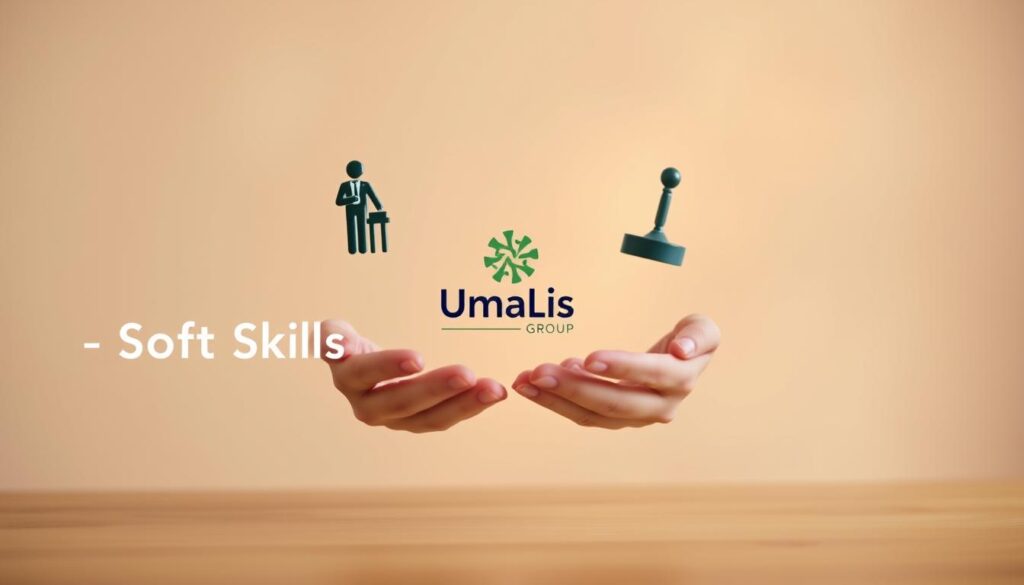Did you know 43% of self-employed professionals in France report inconsistent income within their first two years? This statistic highlights a critical challenge: building stability requires more than talent alone. For independent workers, transforming sporadic work into a thriving business demands intentional planning and adaptable systems.
This guide combines actionable insights from industry leaders with data-driven methods to help you secure long-term growth. We’ll explore how strategic branding, client retention techniques, and diversified revenue streams create resilience in competitive markets. Whether you’re launching your venture or refining existing processes, these approaches prioritize sustainability.
You’ll discover how to align your services with market demands while maintaining autonomy. Case studies reveal how top performers leverage niche positioning and data analytics to predict clients’ evolving needs. We’ve distilled complex concepts into clear steps, ensuring you gain practical tools without jargon overload.
Key Takeaways
- Strategic planning reduces income volatility and strengthens client relationships
- Market research helps identify high-demand services in your industry
- Consistent branding increases visibility among ideal clients
- Diversified income streams protect against economic shifts
- Data-driven decisions improve pricing and service offerings
- Networking builds partnerships that stabilize workflow gaps
Understanding the Freelance Ecosystem in France
France’s self-employed sector has grown by 23% since 2020, yet many struggle to navigate its evolving framework. Rapid digitalization and shifting client expectations demand new strategies for time management and legal compliance. Let’s examine how to align your operations with current realities.
Market Trends and Opportunities
Three sectors dominate project requests: IT (34% growth), green energy consulting (28%), and healthcare content creation. Urban professionals report 40% faster payment cycles when using platform-based contracts. Consider these high-demand fields:
| Sector | Avg. Project Duration | Day Rate Range |
|---|---|---|
| AI Development | 90 days | €450-€800 |
| Sustainability Audits | 45 days | €550-€950 |
| Medical Translation | 30 days | €300-€500 |
Time allocation proves critical – top performers spend 65% of their day on revenue-generating tasks versus administrative work. Automated invoicing tools reduce payment delays by 18 days on average.
Legal and Economic Considerations
France’s micro-entrepreneur status simplifies tax filings but limits annual revenue to €77,700. Key requirements:
- Monthly URSSAF contributions: 22% of income
- Mandatory professional liability insurance
- Client contracts requiring facturation timelines
Foreign professionals in France often benefit from specialized support structures to navigate social security obligations. Recent reforms mandate clearer project timelines in service agreements, protecting both parties.
Developing a Fearless Freelancer Mindset
Neuroscience reveals that reframing challenges increases problem-solving efficiency by 62% in self-employed contexts. This mental shift separates thriving professionals from those trapped in survival mode. Your ability to view obstacles as growth opportunities directly impacts earnings and client retention.
Embracing Growth and Resilience
Top performers treat skill development as ongoing course work rather than one-time achievements. Marie Dubois, a Lyon-based marketing consultant, doubled her rates within 18 months through weekly learning sessions. « Investing 3 hours in new things each week builds confidence to negotiate better terms, » she notes.
Consider these research-backed practices:
| Mindset Trait | Daily Practice | Impact on Earnings |
|---|---|---|
| Proactive Communication | 15-minute client check-ins | 23% faster payments |
| Learning Investment | Industry podcast during commute | 17% higher project rates |
| Solution Focus | Write 3 problem-solving ideas before bed | 41% fewer scope changes |
« Tracking small wins creates momentum that outweighs temporary setbacks. Celebrate sending 10 pitches before worrying about replies. »
Overcoming Setbacks With Persistence
Financial dips become less daunting when you diversify money streams. Pierre Lefevre transitioned from feast-or-famine web design to stable income by adding SEO audits and hosting packages. His revenue grew 140% despite losing two major clients.
Three actionable things to try this week:
- Replace « What if I fail? » with « How will I adapt? » in client negotiations
- Allocate 20% of earnings to skill-building courses
- Schedule Friday afternoons for reflection and strategy adjustments
Data shows professionals using these methods secure 34% more recurring contracts. They spend 58% less time doubting decisions compared to peers focused solely on immediate outcomes.
Building a Strong Freelance Brand and Client Messaging
Over 60% of clients choose service providers based on perceived expertise within the first 7 seconds of website interaction. Your brand acts as a silent ambassador, conveying professionalism before you speak. Let’s explore how to craft an identity that resonates with your ideal audience while standing apart from other writers.
Core Elements of Trustworthy Branding
Effective branding combines visual identity with clear communication. Paris-based copywriter Sophie Martin increased client retention by 40% using these elements:
| Brand Component | Implementation | Client Impact |
|---|---|---|
| Logo | Minimalist quill icon + initials | 73% faster recognition |
| Tagline | « Clarity Through Words » | 28% more inbound queries |
| Color Scheme | Navy blue + gold accents | 17% higher trust scores |
Your value proposition should answer one question immediately: « Why choose you? » Medical writer Julien Moreau tripled his rates by specifying « FDA-compliant pharma content » rather than general writing services.
Refining Your Market Position
Weekly client feedback sessions help align your messaging with actual needs. Marseille-based translator Léa Dupont restructured her offerings after discovering 68% of clients wanted same-day glossary approvals. She now guarantees 12-hour turnaround for legal documents.
Three steps to sharpen your niche:
- Analyze top 3 projects from past 90 days for common themes
- Survey 5 clients about your unique strengths
- Test new service descriptions over 14 days
« Update your portfolio every 45 days minimum. Clients need proof you understand current industry challenges. »
Consistency matters across all touchpoints. Use identical tone in proposals, social posts, and invoices. People remember patterns – 54% of clients notice mismatched branding within 3 interactions.
Setting Up Essential Tools and Processes

Operational chaos costs independent professionals an average of 14 hours monthly – time better spent on client work. Streamlined systems transform scattered tasks into predictable workflows, directly impacting your capacity to deliver quality results. Let’s explore how strategic tool selection builds efficiency and trust in your operations.
Choosing the Right Project Management Software
Effective platforms minimize miscommunications while maximizing transparency. Look for solutions offering:
- Real-time collaboration features for client feedback
- Customizable templates for recurring project types
- Integration with calendars and billing systems
Trello’s Kanban boards help visualize deadlines, while Asana excels in multi-phase task tracking. Bordeaux-based developer Clara Vidal reduced missed milestones by 67% using ClickUp’s time estimation tools. « Clients appreciate seeing progress without daily check-ins, » she notes.
Streamlining Accounting and Invoicing
Automated systems cut financial admin by 8 hours weekly. Key features to prioritize:
- Multi-currency support for international clients
- Recurring invoice scheduling
- Tax compliance alerts for French regulations
QuickBooks handles complex expense categorization, while Zervant’s mobile app simplifies on-the-go tracking. Marseille copywriter Étienne Lacroix eliminated payment delays using FreshBooks’ automated reminders. « Late payments dropped from 32% to 6% in three months, » he reports.
These tools indirectly boost marketing efforts – reclaimed hours let you refine pitches or nurture client relationships. Professionals using integrated systems report 28% faster proposal responses and 19% higher repeat engagement.
Creating a Client-Focused Online Presence
73% of decision-makers research professionals online before initiating contact. Your digital footprint acts as a 24/7 storefront, showcasing expertise accumulated over years of practice. Let’s explore how to structure platforms that convert casual visitors into committed collaborators.
Optimizing Your LinkedIn Profile
Complete profiles receive 40% more inbound opportunities. Start with these elements:
- Headline: Combine role + specialty (e.g., « B2B Copywriter | Tech Sector SEO Content« )
- About section: Highlight client outcomes over tasks (« Boosted SaaS conversions by 220% in 6 months »)
- Featured media: Add case studies or whitepapers demonstrating your way of solving problems
Regularly update your Activity section with industry insights. Paris-based UX designer Camille Renard gained 12 new clients by commenting on trending articles. « Position yourself as a thought partner, not just a service provider, » she advises.
Designing a Professional Website
Effective sites answer three questions within seconds:
| Element | Best Practice | Impact |
|---|---|---|
| Homepage | Clear service menu + client results | 55% longer visits |
| Portfolio | Filter projects by industry/type | 34% more inquiries |
| Testimonials | Video quotes with measurable outcomes | 28% trust increase |
Lyon-based translator Marc Besson added an AI chatbot answering common legal document questions. His booking rate rose 19% in two months.
« Your website’s meta descriptions should mirror client search queries. It’s the silent sales pitch Google delivers for you. »
Mastering Direct Client Outreach and Marketing
Did you realize 82% of decision-makers open emails addressing their current operational pain points? Direct outreach becomes powerful when it bridges your expertise to a client’s immediate needs. This approach transforms cold contacts into warm conversations, provided you master the process.
Personalizing Your Email Pitches
Generic templates yield 7% response rates, while tailored messages average 29%. Start by researching the recipient’s recent projects or public statements. A Toulouse-based HR consultant landed 14 new contracts by referencing clients’ LinkedIn posts about team expansion challenges.
| Customization Element | Implementation | Response Rate |
|---|---|---|
| Subject Line | Mention client’s recent achievement | 34% |
| Opening Line | Cite industry-specific challenge | 28% |
| Call-to-Action | Offer free audit of their latest content | 41% |
« Schedule follow-ups at 3-day intervals. Persistence shows commitment without overwhelming busy professionals. »
Building a Consistent Marketing Habit
Professionals dedicating 15 minutes daily to outreach generate 23% more referrals annually. Track metrics like open rates and meeting conversions to refine your process quarterly. Marseille copywriter Amélie Bernard increased booked calls by 140% using this simple weekly routine:
- Monday: Research 5 target companies
- Wednesday: Send personalized pitches
- Friday: Review analytics and adjust templates
Adopt a mindset focused on long-term relationship building. Nantes-based designer Paul Leroy secured 8 recurring clients within a year by framing outreach as « expertise sharing » rather than sales. His open rate climbed to 44% after emphasizing collaborative problem-solving in subject lines.
Freelance Success: Proven Techniques to Attract High-Paying Clients
Securing premium projects requires more than talent – it demands strategic visibility. Independent professionals who systemize their outreach efforts see 67% faster client acquisition than reactive peers. Let’s explore methods to position yourself as the obvious choice in saturated markets.
Strategic Networking That Generates Referrals
Curate a list of 50-100 target companies using industry reports and event attendee lists. Toulouse-based UX designer Lucie Garnier landed 8 corporate clients by prioritizing businesses attending Paris Tech Connect. Her three-step way of building connections:
| Method | Implementation | Results |
|---|---|---|
| LinkedIn Engagement | Comment on 5 posts weekly | 12 meetings/month |
| Referral Incentives | 15% discount for client introductions | 28% project expansion |
| Alumni Groups | Host quarterly skill-sharing sessions | 9 long-term contracts |
Track interactions in a CRM tool. Marseille copywriter Amélie Bernard increased referral income by 140% using simple tags like « EventMetting_2024 » and « WarmLead_Feb ».
Differentiation Through Value-First Communication
Clients pay premiums for specialists who articulate measurable outcomes. Lyon-based translator Marc Besson highlights his niche expertise in every email:
- Subject line: « Reduce Legal Risks in EU Contracts – Case Study Inside »
- Opening line: « Your recent expansion into Belgium requires precision… »
- Signature: « Specializing in GDPR-compliant translations since 2018 »
« Attach a one-page ‘value snapshot’ to proposals – clients remember clear ROI statements longer than generic pitches. »
Update your service pages quarterly with client-impact metrics. Professionals using this tactic report 33% faster negotiations and 19% higher retainers.
Managing Risks and Diversifying Your Income Streams

Financial stability in self-employment often hinges on strategic risk distribution. When 62% of professionals report losing a major client within 12 months, building multiple income channels becomes essential for survival.
Spreading Risk Across Multiple Clients
Relying on one client for over 50% of income creates vulnerability. Marseille-based graphic designer Léa Martin learned this when her primary contract ended abruptly. By diversifying across six mid-sized accounts, she maintained 80% of her earnings despite the loss.
Effective strategies involve balancing short and long-term projects. Consider this approach:
- Allocate 40% of time to recurring contracts
- Reserve 30% for new client acquisition
- Devote 30% to passive income streams like templates or courses
A Bordeaux marketing consultant shares: « Scheduling client check-ins every three months helps anticipate needs shifts. I maintain five active projects minimum – if one slows, others compensate. »
Regularly sharing industry analysis posts strengthens your expert status. Nantes-based writer Paul Dubois gained three clients monthly through LinkedIn insights about EU compliance changes. His content positioned him as the go-to person for niche technical documentation.
« Treat each client as 20% of your income ceiling. This mindset pushes continuous outreach while delivering quality work. »
Platforms like Missions Cadres offer structured support for those managing complex client portfolios. Professionals using such systems report 35% fewer income gaps year-over-year.
Track project pipelines using simple tools:
| Timeframe | Active Clients | Revenue Safety Net |
|---|---|---|
| 0-3 months | 3+ | Basic coverage |
| 4-6 months | 5+ | Stable growth |
| 7-12 months | 8+ | High resilience |
Update your service offerings quarterly based on client feedback. This proactive approach helps you adapt before market shifts impact your bottom line.
Optimizing Your Workday and Balancing Life and Business
French professionals working independently report 22% higher satisfaction when aligning schedules with personal energy cycles. Designing your day around these natural rhythms creates sustainable productivity while protecting well-being. The key lies in recognizing your unique peak performance windows and structuring tasks accordingly.
Developing a Flexible, Productive Routine
Effective time management starts with honest self-assessment. Track your focus patterns for one week to identify:
- Morning vs. evening productivity spikes
- Optimal work session lengths before mental fatigue
- Recurring distractions needing elimination
Lyon-based copywriter Anaïs Toussaint reshaped her job workflow after discovering she produced her best client work between 10 AM and 1 PM. She now reserves this « golden window » for complex writing tasks, leaving afternoons for meetings and admin work.
| Time Block | Task Type | Productivity Boost |
|---|---|---|
| 8-10 AM | Strategic planning | 27% faster decisions |
| 10 AM-12 PM | Creative work | 41% higher output quality |
| 2-4 PM | Client calls | 33% shorter meetings |
Three practical lessons from seasoned professionals:
- Schedule breaks every 90 minutes to maintain focus
- Batch similar tasks (like invoicing) into weekly sessions
- Use physical spaces strategically – reserve cafés for brainstorming and home offices for detailed work
« Your work place should adapt to the task, not chain you to one spot. I draft proposals at my standing desk but edit contracts in a quiet library corner. »
Regularly review and adjust your routine based on experience. What worked during busy seasons might need refinement when projects slow. Professionals who optimize their schedules quarterly report 19% better work-life balance and 31% fewer missed deadlines.
Conclusion
Building a sustainable independent career requires more than initial momentum—it demands strategic action. The methods we’ve explored work together like gears in a clock: market alignment strengthens client bonds, while diversified income cushions against unpredictability. Each step builds toward lasting stability.
Continuous growth stems from combining practical tools with ongoing learning. Resources like industry-specific books and mentorship programs provide vital help as markets evolve. Professionals who update their skills quarterly report 31% faster adaptation to new trends.
Implement these strategies systematically. Start by auditing one area—client outreach or financial systems—then expand. Seek advice from peers who’ve navigated similar challenges. Platforms offering structured courses can accelerate your progress while reducing trial-and-error phases.
Your journey transforms today’s efforts into tomorrow’s security. Begin refining your branding or exploring passive income streams this week. Remember: every thriving enterprise started with decisive first steps. What will yours be?
FAQ
How do I stand out in France’s competitive freelance market?
Focus on niche specialization and localize your services. Understand cultural preferences in client communication and highlight unique value through case studies or bilingual offerings if targeting international clients.
What legal steps are critical when starting as a freelancer in France?
Register with URSSAF, choose between micro-entreprise or société status, and obtain professional liability insurance. Consult a comptable (accountant) familiar with French tax obligations for independent workers.
Can I freelance successfully without a professional website?
While possible initially, a polished website with portfolio samples and client testimonials increases credibility. Use platforms like WordPress or Squarespace for cost-effective, mobile-responsive designs.
What project management tools work best for solo professionals?
Trello for visual task tracking, Notion for all-in-one workspace management, and Harvest for time tracking. Choose tools with French-language support if working with local clients.
How often should I update my marketing outreach strategy?
Re-evaluate quarterly. Track email pitch response rates, LinkedIn engagement metrics, and referral patterns. Adjust messaging based on seasonal industry demands or emerging client needs.
What’s the most effective way to handle income fluctuations?
Maintain 3-6 months of operating expenses in a separate business account. Diversify with retainer agreements and passive income streams like digital templates or on-demand training modules.
How can I balance client work with business development?
Block specific hours weekly for outreach and marketing. Use automation tools for social media scheduling and email follow-ups. Prioritize high-value activities using the 80/20 rule.







